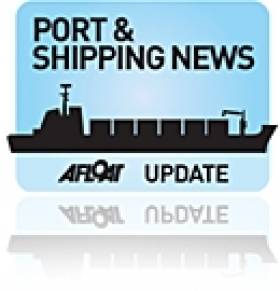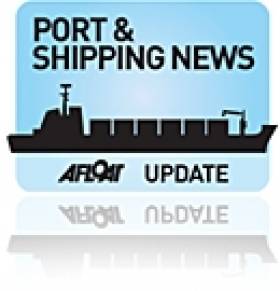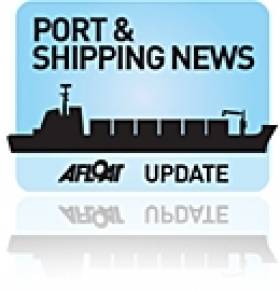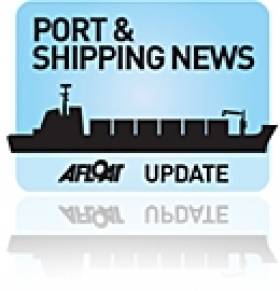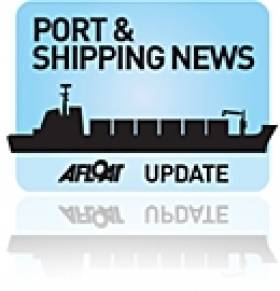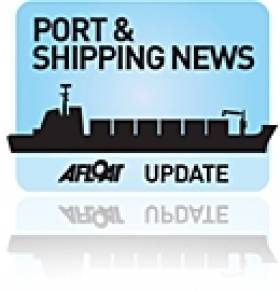Displaying items by tag: Clipper Faith
Former Detained Dublin Port Based Bulk-Carrier Is Renamed
#RenamedBULKER– The former detained 19,354 tonnes bulk-carrier Clipper Faith which was sold last month for €4.5m as previously reported on Afloat.ie has been renamed Island Mariner, writes Jehan Ashmore.
Under the directions of the Admiralty Marshall of the High Court the former Greek operated 181m bulk-carrier completed in 2008 at a Chinese shipyard was sold at public auction. Afloat.ie can reveal the buyer of the Clipper Faith was to another Greek interest, Lynx Shipping Company.
Clipper Faith easily became the largest vessel ever to be sold in an Irish port following the arrest of the vessel in Dublin Port. The plight of her 19-strong Ukrainian crew who had not been paid wages dating back to late last year drew the attention of the authorities.
The 29,501dwt tonnes Clipper Faith had docked in early March after discharging a cargo of animal feed products loaded in New Orleans. Ever since her arrival of more than four months ago, the vessel has had to shift berths on several occasions so to free up quay space for other commercial traffic.
Currently the Island Mariner is moored alongside the Coal Quay on the south quays and in readiness for her departure under her new owners.
Ports & Shipping Review: Maritime Labour Package, Shipping Sector Steady Course, Ferry Service 40th, New Cruise Terminal plus more..
#ShippingReview: Over the last fortnight Jehan Ashmore has reported from the shipping scene where Minister for Transport, Leo Varadkar confirmed a successful Irish Presidency trilogue which dealt with the Maritime Labour Package.
Celtic Link Ferries recorded an increase in both passenger and vehicle traffic for the month of May compared to same period in 2012.
A new ferry route linking Campeltown on the Mull of Kintyre peninsula and Ardrossan on the Firth of Clyde via the Isle of Aran began operations, the first new service for nearly 20 years by CalMac in the region.
Irish based shipping companies (340 vessels) in 2012 experienced a challenging year in operations both with domestic and international, according to the Irish Maritime Development Office (IMDO).
Celebrating this month is the 40th anniversary of Irish Continental Line's Ireland-France route served by Saint Patrick, the service's successor is operated by Irish Ferries.
Cork based Ardmore Shipping's newly launched 49,999dwt tanker Ardmore Seaventure built by SPP Shipbuilding in Korea, was immediately delivered to Cargill on a 12 month time charter arrangement.
Ireland's first custom-built cruise terminal costing £7m is planned for Belfast Harbour, the new facility will be able to handle the next generation ships which carry over 4,500 passengers and crew.
The seized bulk-carrier Clipper Faith (1998/19,354grt) has been sold at auction for €4.8m to Greek owners.
Seized Bulk-Carrier Sold at Auction for €4.8m
#SoldShip – The Belize flagged bulk-carrier Clipper Faith (1998/19,354grt) seized in Dublin Port in March as previously reported on Afloat.ie has been sold at auction for €4.8m reports RTE News.
The crew who had not been paid since December 2012, were paid off and repatriated to their native Ukraine last month following intervention by the International Transport Workers' Federation.
The Clipper Faith was sold to a Greek shipping company. The sale price will now be given to the Admiralty Marshall for distribution to creditors who include Dublin Port and the Amsterdam Trade Bank.
Admiralty Marshall Directs Sale of 'Clipper Faith' Cargo Vessel Berthed in Dublin Port
Clipper Faith, the cargo vessel at the centre of a High Court proceedings earlier this month is to go for public auction by direction of Admiralty Marshall one of the largest vessels directed to be sold this way in recent years.
The auction will be held at 12.00 noon on Friday, 14th June 2013 at the Clarion Hotel, IFSC Centre, North Wall, Dublin 1.
Earlier this month a High Court judge expressed concern for the crew of the Belize registered 19,000 tonnes cargo ship detained in Dublin Port since last March and who have not been paid since late last year.
Further details, photographs & conditions of sale from auctioneer Dominic Daly is below and downloadable MS word file below.
PUBLIC AUCTION
(if not previously sold)
BY DIRECTION ADMIRALTY MARSHALL
THE HIGH COURT
DUBLIN, IRELAND.
M.V. CLIPPER FAITH
IMO No 9149677. Registered Belize City.
Built 1998, China. Bulk Carrier.
L.O.A. 181.00m. B 26.00m. D 14.40m
GRT 19,354. NET 9,614.
Engines Man B&W, 5S50MC, MCR-6400KW, MSR-5760KW
Auction: 12.00 noon on Friday, 14th June 2013
At the Clarion Hotel, IFSC Centre, North Wall, Dublin 1, Ireland.
The vessel is offered For Sale AS SEEN AS IS at Dublin Port.
Further Details, Photographs & Conditions Of Sale from:
DOMINIC J. DALY, AUCTIONEER
PEMBROKE HOUSE, PEMBROKE STREET, CORK, IRELAND.
Tel: (353) 21 4277399 or mobile: (353) 87 2550486
Email: [email protected]
Full advert on the Commercial section of the Afloat Boats for Sale website
Detained Cargoship Shifts Berths for Cruise Caller
#DetainedCargoship – The detained Belize-flagged 19,000 tonnes cargo-bulker, Clipper Faith, previously reported on Afloat.ie, had to shift berths in Dublin port today so in order to accommodate a cruiseship, writes Jehan Ashmore.
In place of the Clipper Faith is the French flagged cruiseship Le Boreal, which is berthed near the East-Link toll-lift bridge along the North Wall Quay extension, the site of the proposed new dedicated cruise terminal which forms part of the Dublin Port masterplan.
Clipper Faith subsequently shifted berths downriver to the channel fairway and docked at the ESB jetty, where the bulker had originally berthed alongside more than two months ago.
Judge Concerned for Crew of Cargoship Detained in Dublin
#DetainedBulker- A High Court judge has expressed concern for the crew of a Belize registered 19,000 tonnes cargo ship detained in Dublin Port since last March and who have not been paid since late last year.
The 17 crew, represented by the International Transport Workers Federation, had brought proceedings against the owner of the MV Clipper Faith for unpaid wages of approximately $320,000.
The ship's owner, the Liberian-registered Afternoon Maritime, said it lacked funds to pay the crew, who are largely from Russia and Ukraine. For more on this story, The Irish Times has a report.


























